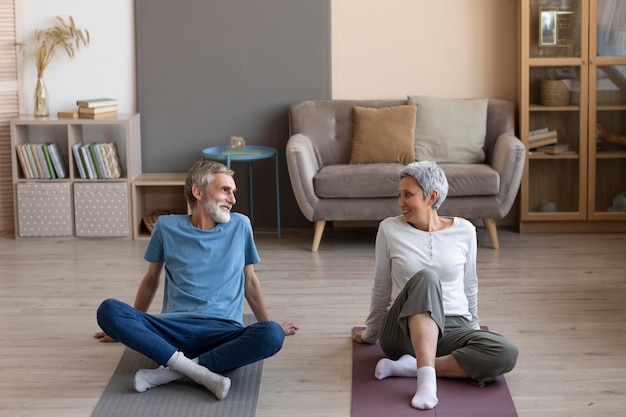Master the art of taking care of elderly patients with muscle weakness. Explore therapy, nutrition, and lifestyle tips.
February 26, 2025

Elderly muscle weakness is a significant health concern that affects the quality of life of senior individuals. It's a multifactorial condition, influenced by various factors including aging, nutrition, and underlying health conditions. Two major contributors to muscle weakness in the elderly are sarcopenia and dynapenia. Understanding these conditions is crucial in providing optimal care for elderly patients with muscle weakness.
Sarcopenia is an age-related condition characterized by the progressive loss of muscle mass and strength, impacting the elderly population and often leading to the need for long-term care. The prevalence of sarcopenia increases with age, ranging from 5% to 13% in individuals ages 60 and older, and surges to between 11% and 50% in those ages 80 and older.
In 2016, sarcopenia was declared a specific disease by the Centers for Disease Control and Prevention (CDC), leading to increased diagnosis and treatment of the condition. It is usually caused by factors such as poor nutrition, low activity levels, chronic diseases, and low hormone levels. In fact, more than 20% of people over the age of 70 are affected by sarcopenia.
Dynapenia, unlike sarcopenia which involves loss of muscle mass, is the age-related loss of muscle strength. Research suggests that the decline in muscle strength is more rapid than the loss of muscle mass in elderly individuals [3].
Both sarcopenia and dynapenia play significant roles in the etiology of muscle weakness in the elderly. These conditions can significantly impact an individual's ability to perform daily activities, thereby affecting their independence and overall quality of life. Therefore, early detection and intervention are crucial in managing these conditions and mitigating their impact on the elderly population.
Identifying muscle weakness in elderly patients is the first step towards providing appropriate and effective care. This process involves being vigilant to specific symptoms and conducting comprehensive diagnostic procedures.
Muscle weakness in geriatric patients can manifest in various ways. It may appear suddenly over weeks or months, or it may develop gradually over many years. Sudden onset weakness may be related to other conditions or medications. Some common signs to watch out for include difficulty in performing routine tasks, reduced mobility, and decreased strength. It's also essential to note any changes in the individual's ability to walk, climb stairs, or shift positions, as this could indicate a decline in muscle strength.
When it comes to diagnosing muscle weakness in the elderly, a comprehensive and multifaceted approach is often required. A physical exam conducted by a PM&R physician (Physical Medicine and Rehabilitation) will focus on identifying weak muscles, testing reflexes, and assessing the patient's sensory functions to distinguish between muscle-based and brain-based problems.
Diagnostic processes for muscle disease involve assessing the patient's ability to move, stand, walk, perform daily tasks, along with blood tests, X-rays, and sometimes electrical activity tests or muscle biopsies. These tests can help identify the extent of muscle weakness and guide the development of an appropriate care plan [2].
By understanding the signs of muscle weakness and conducting thorough diagnostic procedures, healthcare providers can ensure that elderly patients receive the care they need. This can help improve their quality of life, enhance their independence, and prevent conditions like muscle atrophy due to lack of physical activity [4].
Managing muscle weakness in the elderly involves a two-pronged approach: physical therapy and the use of assistive devices. Both these strategies aim to improve mobility, strength, and overall quality of life.
Geriatric physical therapy plays a crucial role in taking care of elderly patients with muscle weakness. This form of therapy focuses on helping older adults strengthen the muscles needed for everyday tasks like walking, climbing stairs, and shifting positions, which can improve independence and prevent conditions like muscle atrophy due to lack of physical activity [4].
Physical therapy for older adults should include exercises that improve strength, flexibility, endurance, and balance to prevent deconditioning. The exercises usually incorporate body weight or light weights to avoid overloading joints.
Older adults over the age of 65 are advised to engage in physical activity daily, even if it's light like walking around the home, cooking, or cleaning. It is recommended to perform exercises that enhance strength, balance, and flexibility at least two days a week to prevent weakness, muscle atrophy, and falls [4].
Seniors should aim to accumulate a minimum of 150 minutes of moderate-intensity physical activity over a week to maintain functional strength, endurance, and range of motion. These activities may include brisk walking, hiking, aerobics, cycling, dancing, as well as sports and recreational activities [4].
Assistive devices such as canes, crutches, and walkers can be used to increase a patient's base of support, improve balance, and increase activity and independence [5].
However, it's important to note that the act of lifting and advancing the device can result in the destabilization of biomechanical forces, and balance may be disrupted by the need to allocate attention to device control [5].
Selection of a suitable device depends on the patient's strength, endurance, balance, cognitive function, and environmental demands. It's essential to remember that most patients with assistive devices have never been instructed on the proper use and often have devices that are inappropriate, damaged, or are of the incorrect height.
By combining the benefits of physical therapy and the strategic use of assistive devices, older adults dealing with muscle weakness can improve their mobility, maintain their independence, and enhance their overall quality of life.
In the context of muscle weakness in the elderly, exercise therapy plays a pivotal role. Two critical components of such therapy are resistance training and balance exercises.

Resistance training is a potent stimulus for muscle metabolism and turnover, improving muscle function and decelerating the development of muscle weakness. It has been found to be an effective measure in enhancing muscle metabolism, function, and overall quality of life in the elderly. Researchers have discovered that such training can lead to significant benefits, particularly for elderly patients dealing with muscle weakness due to sarcopenia and dynapenia.
Resistance training typically involves exercises that make your muscles work against a weight or force. These can include lifting weights, using resistance bands, or performing body weight exercises such as push-ups and squats.
The key is to start slow, with lighter weights and fewer repetitions, gradually increasing as strength and endurance build. It's essential, however, to seek professional guidance before embarking on a resistance training routine, to ensure the exercises are being performed correctly and safely.
Another crucial aspect of exercise therapy for elderly patients with muscle weakness is balance exercises. These exercises are essential to prevent accidental falls, which pose a significant risk for this population. By enhancing balance and stability, these exercises make it easier for elderly individuals to walk on uneven surfaces without losing balance.
Balance exercises can take various forms, including standing leg lifts, heel-to-toe walks, and tai chi or yoga practices. These exercises not only improve balance but also help strengthen the lower body muscles, contributing to overall mobility and physical stability.
As with resistance training, it's important to start with simpler exercises, gradually moving to more complex routines as balance improves. Incorporating balance exercises into the daily routine can significantly improve quality of life by enhancing mobility, independence, and confidence in elderly patients dealing with muscle weakness.
In conclusion, a well-rounded exercise regimen, consisting of both resistance and balance exercises, can play a significant role in managing muscle weakness in the elderly. However, it's important to remember that each individual's capabilities and health status are different, and therefore, any exercise plan should be personalized, considering the individual's specific needs and limitations.
Nutrition plays a pivotal role in taking care of elderly patients with muscle weakness. As individuals age, their energy requirements may decrease due to loss of muscle mass, but the need for essential nutrients such as carbohydrates, fat, protein, vitamins, minerals, and water remains the same or may even increase Better Health Victoria.
Protein is essential for building and maintaining healthy bones and muscles. Good sources of protein include meats, fish, eggs, dairy, soy products, beans, nuts, seeds, and whole grains. For elderly patients, spreading protein intake throughout the day can be beneficial, especially if their appetite is reduced. This ensures that they receive a steady supply of this essential nutrient to support their muscle health Better Health Victoria.
| Protein Source | Examples |
|---|---|
| Animal-Based | Meats, Fish, Eggs, Dairy |
| Plant-Based | Soy Products, Beans, Nuts, Seeds, Whole Grains |
In addition to protein, calcium and vitamin D are crucial for bone health and muscle function. Older individuals require additional calcium for strong bones and teeth. Good sources of calcium include low-fat milk, yogurt, cheese, tinned salmon, sardines, leafy greens, sesame seeds, almonds, etc Better Health Victoria.
| Calcium Source | Examples |
|---|---|
| Dairy-Based | Low-Fat Milk, Yogurt, Cheese |
| Non-Dairy | Tinned Salmon, Sardines, Leafy Greens, Sesame Seeds, Almonds |
Vitamin D, on the other hand, can be obtained through sun exposure or dietary sources such as egg yolk, butter, milk, cheese, liver, and fish. For those who struggle to get enough vitamin D from their diet, supplements may be recommended. In addition to a healthy diet, weight-bearing exercises like walking are important for bone health Better Health Victoria.
| Vitamin D Source | Examples |
|---|---|
| Dietary Sources | Egg Yolk, Butter, Milk, Cheese, Liver, Fish |
| Non-Dietary Sources | Sun Exposure |
Adequate intake of protein, calcium, and vitamin D, coupled with regular exercise, can help support muscle strength and health in the elderly. It's important to consult with a healthcare provider or dietitian to ensure a well-balanced diet that meets the individual's specific nutritional needs.
Managing muscle weakness in the elderly involves a combination of regular physical activity and dietary modifications. These changes can significantly affect the quality of life, independence, and overall health of senior citizens.
Regular physical activity plays a vital role in taking care of elderly patients with muscle weakness. Geriatric physical therapy focuses on helping older adults strengthen the muscles needed for everyday tasks like walking, climbing stairs, and shifting positions, which can improve independence and prevent conditions like muscle atrophy due to lack of physical activity [4].
It is recommended that generally fit Americans aged 65 and older should be able to incorporate 150 minutes of moderate endurance activity into their week, which can include activities like walking, swimming, cycling, and strength training exercises to improve strength, flexibility, and balance.
For older adults with muscle weakness, building strength can be achieved with exercises like abdominal contractions, wall pushups, pelvic tilts, shoulder blade squeezes, toe taps, heel raises, knee lifts, shoulder and upper back stretches, ankle rotations, and other strength-building routines that can be done at home without the need for a gym [6].
Incorporating balance exercises into the exercise regimen of older adults with muscle weakness is essential to prevent accidental falls, which are a significant risk for this population. Balance exercises, tai chi, or yoga can help improve balance and make it easier to walk on uneven surfaces without losing balance.
In addition to regular physical activity, dietary modifications can significantly contribute to managing muscle weakness in the elderly. More than 20% of people over age 70 have sarcopenia, which is characterized by a loss of muscle mass and strength. Sarcopenia is usually caused by poor nutrition, low activity, chronic diseases, and low hormone levels [2].
To combat sarcopenia, it is crucial to maintain a balanced diet rich in protein, calcium, and vitamin D. Protein helps in muscle building and repair, calcium is essential for bone health, and vitamin D aids in calcium absorption.
It's also vital to stay hydrated and consume enough calories to fuel daily activities. If necessary, a dietician or nutritionist can provide personalized meal plans that cater to individual nutritional needs and preferences. In some cases, supplements may be recommended to ensure adequate nutrient intake.
In conclusion, a combination of regular physical activity and appropriate dietary changes can significantly help manage muscle weakness in the elderly, improving their quality of life and independence. It's important to consult with healthcare professionals for personalized advice and treatment plans.
[1]: https://my.clevelandclinic.org/health/diseases/23167-sarcopenia
[2]: https://www.aapmr.org/about-physiatry/conditions-treatments/pain-neuromuscular-medicine-rehabilitation/adult-geriatric-muscle-disease
[3]: https://eurapa.biomedcentral.com/articles/10.1007/s11556-012-0102-8
[4]: https://www.verywellhealth.com/geriatric-physical-therapy-5189469
[5]: https://www.aafp.org/pubs/afp/issues/2011/0815/p405.html
[6]: https://www.healthline.com/health/everyday-fitness/senior-workouts
09:00 AM - 06:00 PM
Monday - Friday
2488 Grand Concourse Suite 409, Bronx, NY, 10458
T: 718-305-5858
F: 718-305-6258
1 Smith Street, 3rd Floor, Brooklyn, New York, 11201
T: 718-305-5959
F: 718-305-6259
2361 Nostrand Ave Suite 401 Brooklyn, NY 11210.
T: 718-305-6060
F: 718-305-6260
576 Central Ave # 301, East Orange, NJ 07018
433 Woodbury Glassboro Road Sewell, NJ 08080
1172 Fischer Blvd, Toms River, NJ 08753
T: (973) 678-5500
njinfo@h2hhc.com








